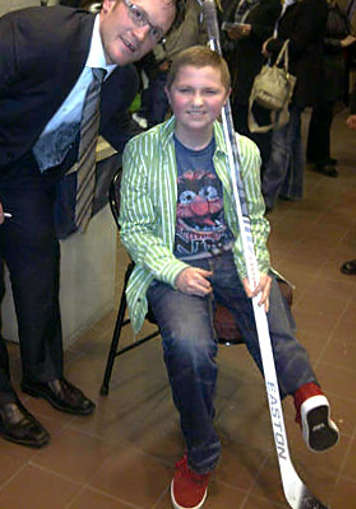When you have cancer of the bone or the soft tissue of your arm or leg, you will probably need surgery to remove the tumour, usually after you have had some chemotherapy.
You may hear about three types of surgery:
- limb sparing surgery
- rotationplasty
- amputation
An orthopedic surgeon (bone surgery specialist) performs these operations. They will explain the different types of surgery and will discuss with you and your parent/caregiver which one will be the best for you. In the past, most teens had an amputation, but now most will have limb sparing surgery or a rotationplasty instead. Each surgery has its pros and cons and each surgery requires different rehabilitation afterwards. In some cases, you will be given a choice between two types of surgeries and it will be up to you to decide which makes sense for your lifestyle and goals.
Limb-sparing surgery
Limb-sparing surgery allows adolescents with bone or soft tissue tumours to keep their arm or leg. In this kind of surgery, your orthopedic surgeon will remove the tumour from your arm or leg and then replace the bone that was removed with a piece of healthy bone from one of your other limbs or an internal prosthesis (implant). An implant is a specially-designed piece of metal that acts like the bone that was taken out.
It is not always possible to do a limb-sparing surgery and this type of surgery often has a long rehabilitation phase and some special care required with physical activity in the future.

Rotationplasty
Rotationplasty is a special type of limb-sparing surgery. It is usually only done if the cancer is in your leg (typically involving the bones of your knee joint) and your orthopedic surgeon thinks that it is possible to do the surgery.
The first part of the operation is like having an amputation. Your orthopedic surgeon removes your leg at a place just above where your tumour is. Then they will remove the tumour from your amputated leg. In the last part of the surgery, the bottom part of your leg, where there is no tumour, is then re-attached to the part of your leg above the knee, but it is put on backwards. We know this sounds strange, but many adolescents like this surgery because your ankle can act as a knee joint when you have your prosthesis. This means you have better function, especially when walking, running and playing sports.
Amputation
Amputation means that the surgeon will remove all or part of the limb.
My surgeon says I need a limb surgery and I’m really scared!
Being scared is a normal reaction to learning that you’re going to have major surgery on one of your limbs. It is a huge change to deal with! Below are some answers to common questions you may have.
How long will the surgery take?
Depending on the surgery and the area, these surgeries can take anywhere from a couple of hours to six hours.
Will I feel pain?
During the surgery you will be under anaesthetic that will keep you from feeling pain. You may also have what’s called a nerve block. A nerve block stops the nerves that sense pain from sending pain messages to your brain. This can help reduce pain after the surgery too.
After you wake up from the anaesthetic, you will be given medications to help control your pain. These are major surgeries so most patients do feel pain afterward. Your doctor will prescribe pain medications (opioids) to help control pain. In the weeks and months following your surgery, the kind of pain you feel may change. It may become what’s called neuropathic (say: NOO-roe-path-ik) pain. Neuropathic pain can be caused by nerve damage and is treated with a different kind of pain medication. Make sure you keep in touch with your health-care team and tell them how and what you’re feeling.
What is phantom limb sensation or pain?
Phantom limb sensation is the feeling that the limb that was amputated is still there. Phantom limb pain is a painful sensation from the place where your limb used to be. For example, if you've had a below-the-knee amputation, you could feel pain coming from where your foot used to be. Or it might feel to you like that foot is still there, as part of your body. These feelings are called 'phantom' because that part of the body isn’t there anymore. Often, phantom limb sensation or pain will go away over time. If you are experiencing pain, talk to your health-care team. It may be treated with medication or massage.
How quickly will I recover from surgery?
It can be a frustrating answer, but the truth is that recovery times are different for each person. The days right after surgery are often the hardest. Even sitting up can be a challenge, but it’s an important first step to adjusting to the changes in your body. Walking can be difficult even if it's an arm that has had surgery. You’ll wonder when you’ll be able to get back to normal. Recovery will take time but try to be patient: it will happen. It’s very important to work closely with your physiotherapist, who will guide you through recovery.
When will my rehabilitation begin?
You will most likely start working on recovering your strength and mobility right away. You will probably be seen by a physiotherapist a few days after surgery to get you moving and give you some specific exercises, depending on the type of surgery you have had.
Once you are discharged from the hospital, you will be closely followed by one of the physiotherapists who work in oncology. They will guide you through your rehabilitation throughout your treatment. Sometimes, home physiotherapy is put in place or patients/families may decide to get private therapy. Every surgery and situation is different, so speak to your health-care team and physiotherapist to help decide what is best for your situation.
When can I get a prosthesis?
Once the surgeons feel the wound is completely healed, you’ll be referred to a prosthetic specialist. They will take a cast of your limb and then start to make your prosthesis. This process takes some time and waiting can be frustrating. However, once the prosthesis is ready, you will get to try it. You will work with your therapists closely until they are sure you know how to put it on and take it off properly and that you are using it safely.
After you get a prosthesis, it can take a while to learn to use it. Try not to be too disappointed. Your health-care team will ensure you are linked with the appropriate rehabilitation centre that will help guide you throughout your prosthetic fitting and rehabilitation. Just like any other skill, using a prosthesis takes time and practice to do well.
How will I feel about the change to my body?
This is a really difficult question. The important thing is to try not to focus on what you have lost and instead focus on the body you have left and what you are still able or can learn to do. Of course this is easier said than done but focusing on your abilities can help you accept the changes caused by your limb surgery. For more tips on adjusting, check out our section on body image.
How will others react?
Seeing friends and family for the first time after your surgery can be difficult. It can feel awkward for you and for them as you all adjust. Just try to be yourself. Being open and talking about what your limb can do now can actually make it a little easier on everyone. Check out the section on communication for tips on how to talk about difficult subjects.
I still have questions!
If you still have questions, your best source of information is your health-care team. They know you and your family and they understand your cancer, your amputation and the resources that are available in your community. They can help you find what you need.







